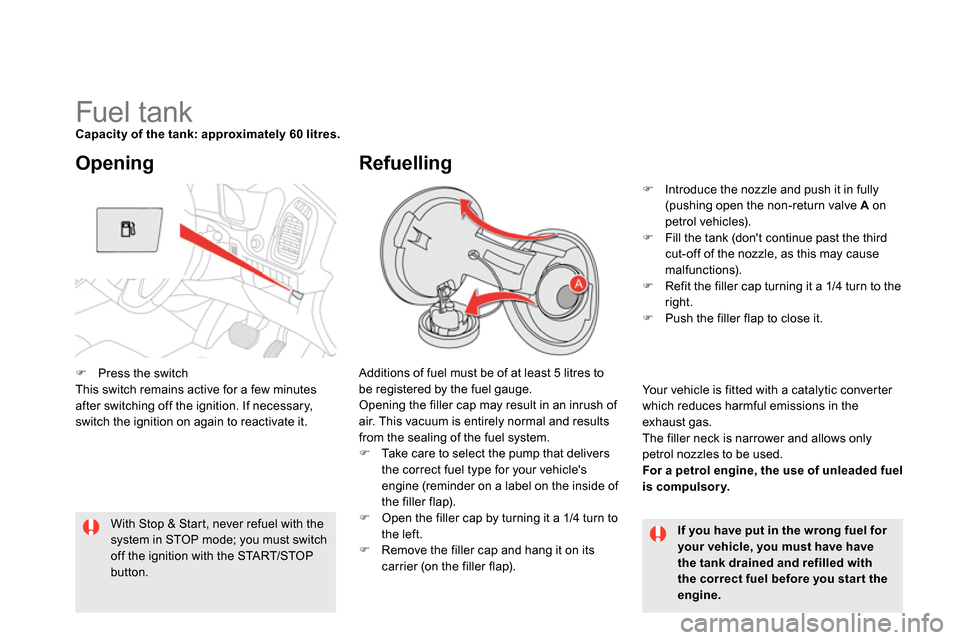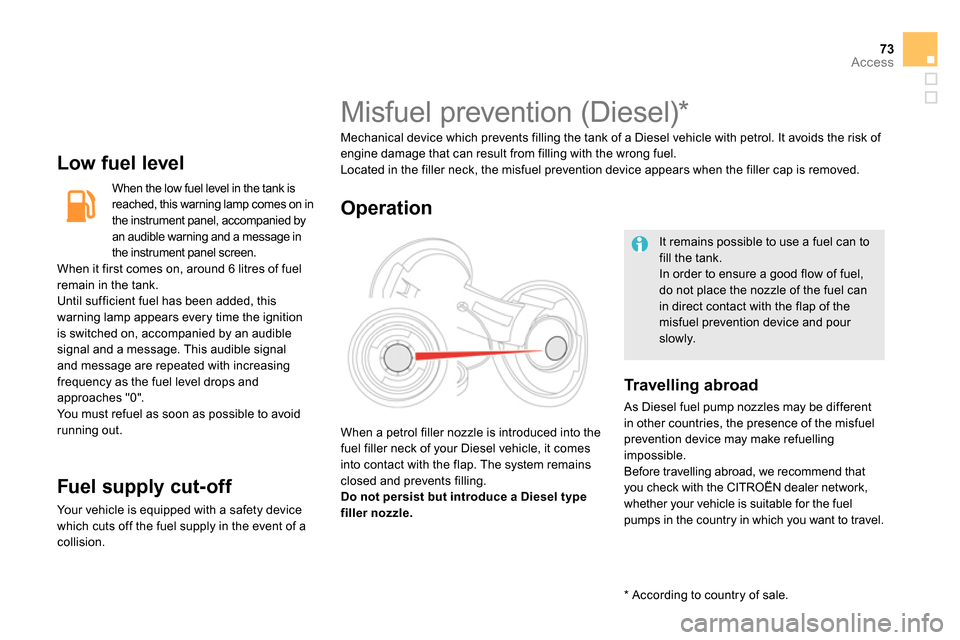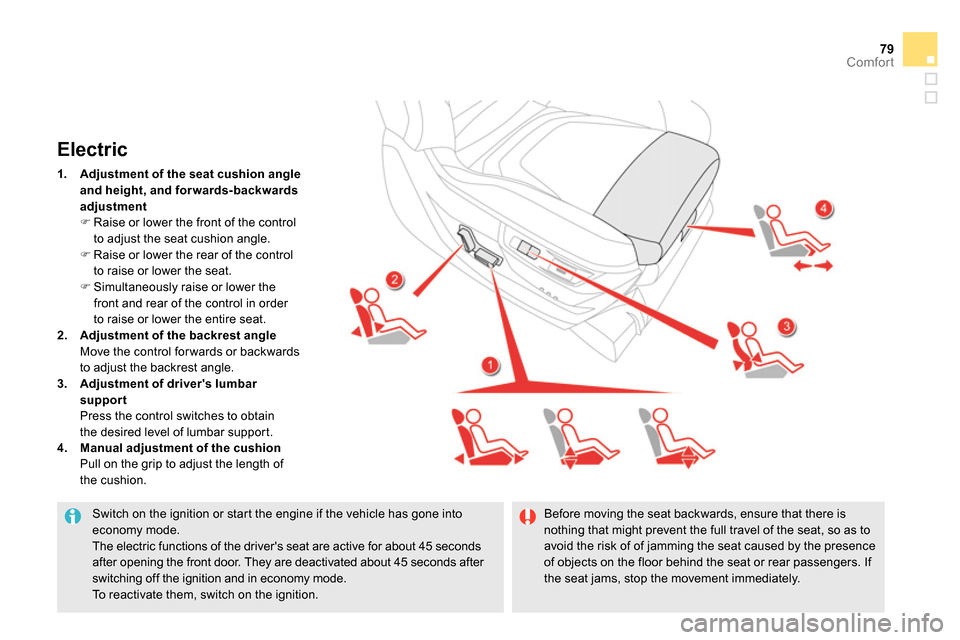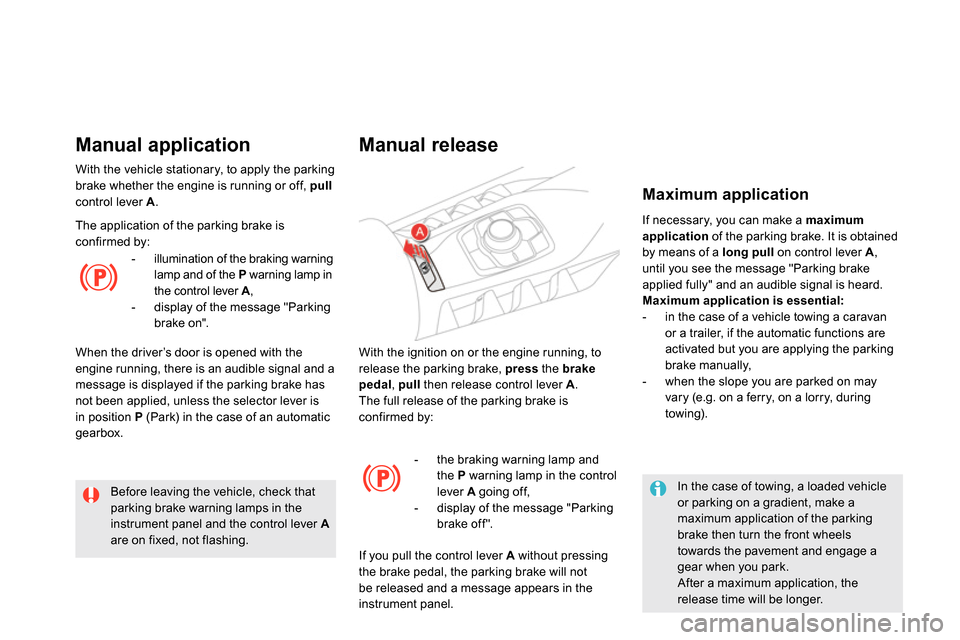ignition Citroen DS5 2013.5 1.G Owner's Guide
[x] Cancel search | Manufacturer: CITROEN, Model Year: 2013.5, Model line: DS5, Model: Citroen DS5 2013.5 1.GPages: 372, PDF Size: 32.58 MB
Page 69 of 372

OFF
OFF
67Access
Reactivation of the interior
volumetric and anti-tilt monitoring
Triggering of the alarm
This is indicated by sounding of the siren
and flashing of the direction indicators for
thirty seconds.
The monitoring functions remain active until
the alarm has been triggered eleven times in
succession.
Press the unlocking button on
the remote control or unlock the
vehicle using the Keyless Entry
and Starting system to deactivate
the exterior perimeter monitoring.
Press the locking button on the
remote control or lock the vehicle
using the Keyless Entry and
Starting system to activate all the
monitoring functions.
The indicator lamp in the button
again flashes once per second.
When the vehicle is unlocked using
the remote control or unlocked
using the Keyless Entry and Starting
system, rapid flashing of the indicator
lamp in the button informs you that the alarm
was triggered during your absence. When
the ignition is switched on, this flashing stops
immediately.
Failure of the remote control
To deactivate the monitoring functions:
Unlock the vehicle using the key (integral
with the remote control) in the driver's door
lock.
Open the door; the alarm is triggered.
Switch on the ignition; the alarm stops. The
indicator lamp in the button goes off.
Locking the vehicle without
activating the alarm
Lock or deadlock the vehicle using the key
(integral with the remote control) in the
driver's door lock.
Operating fault
When the ignition is switched on, fixed
illumination of the indicator lamp in the button
indicates a fault in the system.
Have it checked by a CITROËN dealer or a
qualified workshop.
*
According to country.
Automatic activation *
2 minutes after the last door or the boot is
closed, the system is activated automatically.
To avoid triggering the alarm on entering
the vehicle, first press the unlocking button
on the remote control or unlock the vehicle
using the Keyless Entry and Starting
system.
Page 70 of 372

Electric windows
1.
Left hand front electric window switch.
2.
Right hand front electric window switch.
3.
Right hand rear electric window switch.
Manual operation
To open or close the window, press or pull the
switch gently. The window stops as soon as the
switch is released.
Automatic operation
To open or close the window, press or pull
switch fully: the window opens or closes
completely when the switch is released.
Pressing the switch again stops the movement
of the window.
The electric window switches remain
operational for approximately 45 seconds after
switching off the ignition.
Once this time has elapsed, the electric
windows will not operate. To reactivate them,
switch the ignition on again.
4.
Left hand rear electric window switch.
5.
Deactivating the rear electric window
switches,
locking the rear doors
(child lock).
Page 74 of 372

Fuel tank
Capacity of the tank: approximately 60 litres
.
Additions of fuel must be of at least 5 litres to
be registered by the fuel gauge.
Opening the filler cap may result in an inrush of
air. This vacuum is entirely normal and results
from the sealing of the fuel system.
Take care to select the pump that delivers
the correct fuel type for your vehicle's
engine (reminder on a label on the inside of
the filler flap).
Open the filler cap by turning it a 1/4 turn to
the left.
Remove the filler cap and hang it on its
carrier (on the filler flap).
Opening
If you have put in the wrong fuel for
your vehicle, you must have have
the tank drained and refilled with
the correct fuel before you star t the
engine.
With Stop & Start, never refuel with the
system in STOP mode; you must switch
off the ignition with the START/STOP
button.
Refuelling
Introduce the nozzle and push it in fully
(pushing open the non-return valve A
on
petrol vehicles).
Fill the tank (don't continue past the third
cut-off of the nozzle, as this may cause
malfunctions).
Refit the filler cap turning it a 1/4 turn to the
right.
Push the filler flap to close it.
Your vehicle is fitted with a catalytic converter
which reduces harmful emissions in the
exhaust gas.
The filler neck is narrower and allows only
petrol nozzles to be used.
For a petrol engine, the use of unleaded fuel
is
compulsory.
Press the switch
This switch remains active for a few minutes
after switching off the ignition. If necessary,
switch the ignition on again to reactivate it.
Page 75 of 372

73Access
Low fuel level
When the low fuel level in the tank is
reached, this warning lamp comes on in
the instrument panel, accompanied by
an audible warning and a message in
the instrument panel screen.
When it first comes on, around 6 litres of fuel
remain in the tank.
Until sufficient fuel has been added, this
warning lamp appears every time the ignition
is switched on, accompanied by an audible
signal and a message. This audible signal
and message are repeated with increasing
frequency as the fuel level drops and
approaches "0".
You must refuel as soon as possible to avoid
running out.
Fuel supply cut- of f
Your vehicle is equipped with a safety device
which cuts off the fuel supply in the event of a
collision. It remains possible to use a fuel can to
fill the tank.
In order to ensure a good flow of fuel,
do not place the nozzle of the fuel can
in direct contact with the flap of the
misfuel prevention device and pour
slowly.
Misfuel prevention (Diesel) *
Mechanical device which prevents filling the tank of a Diesel vehicle with petrol. It avoids the risk of
engine damage that can result from filling with the wrong fuel.
Located in the filler neck, the misfuel prevention device appears when the filler cap is removed.
When a petrol filler nozzle is introduced into the
fuel filler neck of your Diesel vehicle, it comes
into contact with the flap. The system remains
closed and prevents filling.
Do not persist but introduce a Diesel type
filler nozzle.
Operation
Travelling abroad
As Diesel fuel pump nozzles may be different
in other countries, the presence of the misfuel
prevention device may make refuelling
impossible.
Before travelling abroad, we recommend that
you check with the CITROËN dealer network,
whether your vehicle is suitable for the fuel
pumps in the country in which you want to travel.
*
According to country of sale.
Page 81 of 372

79Comfort
Switch on the ignition or start the engine if the vehicle has gone into
economy mode.
The electric functions of the driver's seat are active for about 45 seconds
after opening the front door. They are deactivated about 45 seconds after
switching off the ignition and in economy mode.
To reactivate them, switch on the ignition.
Electric
1.
Adjustment of the seat cushion angle
and height, and for wards-backwards
adjustment
Raise or lower the front of the control
to adjust the seat cushion angle.
Raise or lower the rear of the control
to raise or lower the seat.
Simultaneously raise or lower the
front and rear of the control in order
to raise or lower the entire seat.
2.
Adjustment of the backrest angle
Move the control for wards or backwards
to adjust the backrest angle.
3.
Adjustment of driver's lumbar
support
Press the control switches to obtain
the desired level of lumbar support.
4. Manual adjustment of the cushion
Pull on the grip to adjust the length of
the cushion.
Before moving the seat backwards, ensure that there is
nothing that might prevent the full travel of the seat, so as to
avoid the risk of of jamming the seat caused by the presence
of objects on the floor behind the seat or rear passengers. If
the seat jams, stop the movement immediately.
Page 82 of 372

Storing driving positions
System which stores the electrical settings
of the driver's seat and the head-up display
settings. It enables you to store up to
two positions using the buttons on the side
of the driver's seat.
Storing a position using
buttons M / 1 / 2
Switch on the ignition.
Adjust your seat and the head-up display.
Press button M
, then press button 1
or 2
within four seconds.
An audible signal indicates that the position
has been stored.
Storing a new position cancels the previous
position.
Recalling a stored position
Briefly press button 1
or 2
to recall the
corresponding position.
An audible signal indicates the end of the
adjustment.
You can interrupt the current movement
by pressing button M
, 1
or 2
or by using
one of the seat controls.
A stored position cannot be recalled
while driving.
Recalling stored positions is
deactivated 45 seconds after switching
off the ignition.
Page 88 of 372

Mirrors
Each fitted with an adjustable mirror glass
providing the lateral rear ward vision necessary
for overtaking or parking. They can also be
folded for parking in confined spaces.
Door mirrors
If the mirrors are folded using control A
,
they will not unfold when the vehicle is
unlocked.
The folding and unfolding of the door
mirrors using the electronic key can be
deactivated by a CITROËN dealer or a
qualified workshop.
Fold the mirrors when putting your
vehicle through an automatic car wash.
The objects obser ved are, in reality,
closer than they appear.
Take this into account in order to
correctly judge the distance of vehicles
approaching from behind.
Demisting - Defrosting
Adjustment
Turn control A
to the right or to the left to
select the corresponding mirror.
Move control A
in all four directions to
adjust.
Return control A
to the central position.
Folding
Automatic: lock the vehicle using the
electronic key.
Unfolding
Automatic: unlock the vehicle using the
electronic key. Manual: with the ignition on, move
control A
downwards.
Manual: with the ignition on, move
control A
upwards.
Demisting-defrosting of the door
mirrors operates by switching on
the heated rear screen.
For more information, refer to
the "Rear screen demist-defrost" section.
The rear screen demist - defrost
can only operate when the engine is
running.
The mirrors can be folded manually if
necessary.
Page 107 of 372

105Driving
Switching off using the
electronic key
Immobilise the vehicle.
Electronic key left in the reader
If the electronic key is left in the reader,
on opening the driver's door a message
appears to warn you.
Stopping with the "Keyless
Entry and Starting" system
Immobilise the vehicle.
If the vehicle is not immobilised, the
engine will not stop.
Ignition on without
starting
With the electronic key inside
the vehicle, press the " START/
STOP
" button.
The engine stops and the
steering column locks.
Press the " START/STOP
"
button.
The engine stops and the
steering column locks.
Anti-theft protection
Electronic engine immobiliser
The keys contain an electronic chip which has
a secret code. When the ignition is switched
on, this code must be recognised in order for
starting to be possible.
This electronic engine immobiliser locks the
engine management system a few minutes
after the ignition is switched off and prevents
starting of the engine by anyone who does not
have the key.
In the event of a malfunction, you are informed
by a message in the instrument panel screen.
In this case, your vehicle does not start; contact
a CITROËN dealer as soon as possible.
With the electronic key in the reader or the
Keyless Entry and Starting key inside the
vehicle, pressing the "START/STOP" button,
with no action on the pedals
, allows the
ignition to be switched on.
Remove the electronic key from the reader.
Press the "START/STOP" button,
the instrument panel comes on
but the engine does not start.
Press the button again to switch
off the ignition and so allow the
vehicle to be locked.
With the ignition on, the system goes
into energy economy mode when
necessary to maintain the state of
charge of the battery.
Switching off the engine leads to a loss
of braking assistance.
Page 109 of 372

107Driving
It is recommended that you do not
apply the parking brake in very cold
conditions (ice) and during towing
(breakdown, caravan...).
For this, with the ignition on, deactivate
the automatic functions and release the
parking brake manually:
Manual gearbox:
engage first gear
or reverse.
Electronic gearbox:
select
position A
or R
.
Automatic gearbox:
select
position P
or R
.
The electric parking brake combines
2 operating modes:
- Automatic Application/Release
Application is automatic when the engine
stops, release is automatic on use of the
accelerator (this mode is activated by
default),
- Manual Application/Release
Manual application of the parking brake is
done by pulling control lever A.
Manual release is done by pulling
then
releasing the control lever, while pressing
the brake pedal.
When the driver's door is opened, there is an
audible signal and a message is displayed if
the brake is not applied.
Programming the automatic
mode
Depending on the country of sale of the vehicle,
the automatic application when the engine is
switched off and the automatic release when
you press the accelerator can be deactivated.
You can contact a CITROËN dealer or a
qualified workshop to have it activated.
In this case, programming is done via
the configuration menu.
Electric parking brake
If deactivated, the parking brake must
be applied and released manually.
If this warning lamp comes on in
the instrument panel, the automatic
mode is deactivated.
Never leave the vehicle without
checking that the parking brake is on.
This warning lamp comes on
fixed.
Label on door panel
Page 110 of 372

With the ignition on or the engine running, to
release the parking brake, press
the brake
pedal
, pull
then release control lever A
.
The full release of the parking brake is
confirmed by:
Manual release
- the braking warning lamp and
the P
warning lamp in the control
lever A
going off,
- display of the message "Parking
brake off ".
If you pull the control lever A
without pressing
the brake pedal, the parking brake will not
be released and a message appears in the
instrument panel.
If necessary, you can make a maximum
application
of the parking brake. It is obtained
by means of a long pull
on control lever A
,
until you see the message "Parking brake
applied fully" and an audible signal is heard.
Maximum application is essential:
- in the case of a vehicle towing a caravan
or a trailer, if the automatic functions are
activated but you are applying the parking
brake manually,
- when the slope you are parked on may
vary (e.g. on a ferry, on a lorry, during
towing).
Maximum application
In the case of towing, a loaded vehicle
or parking on a gradient, make a
maximum application of the parking
brake then turn the front wheels
towards the pavement and engage a
gear when you park.
After a maximum application, the
release time will be longer.
Before leaving the vehicle, check that
parking brake warning lamps in the
instrument panel and the control lever A
are on fixed, not flashing.
With the vehicle stationary, to apply the parking
brake whether the engine is running or off, pull
control lever A
.
Manual application
The application of the parking brake is
confirmed by:
- illumination of the braking warning
lamp and of the P
warning lamp in
the control lever A
,
- display of the message "Parking
brake on".
When the driver’s door is opened with the
engine running, there is an audible signal and a
message is displayed if the parking brake has
not been applied, unless the selector lever is
in position P
(Park) in the case of an automatic
gearbox.